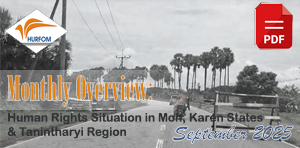Tier 2 Watch List mirrors real incidence of trafficking on the border
July 19, 2013
WCRP: In February of this year, a Mon broker from Mudon Township coerced Mi Nu (an alias) and her two young children to migrate to Thailand. He explained to her that she would be placed as a domestic worker and that the job would be easier than alternatives like construction or factory work. She believed the broker and left with him and her children for Thailand. Since that day, Mi Nu has had no contact with her relatives or neighbors and the broker has not been seen again.
This story was shared with a WCRP field reporter earlier this month by relatives of 30-year-old Mi Nu. While it does not have a definitive end, and family members still hope that she and her 8-year-old daughter and 1-year-old son are safely living in Thailand, the narrative highlights the doubts, suspicion, and risks that shroud many stories of migration between Burma and Thailand. Variations on this account have become startlingly common in border communities and throughout the country, and are reflected in international reporting on human trafficking in Burma.
For example, every year since 2001, the U.S. State Department has released a “Trafficking in Persons” (TIP) report as a tool to engage countries around the world on the issue of human trafficking. The report uses a four-tiered system to rank governments on a scale of compliance with the minimum standards set forth in the U.S.’ Trafficking Victims Protection Act of 2000. For 11 straight years, Burma remained on the list’s bottom rung, Tier 3, but in 2012 was upgraded to Tier 2 Watch List. This classification, which Burma received a second time in June 2013, indicates that the government is making efforts toward compliance but the number of trafficking victims remains high, there was a failure to provide evidence of increased action to combat trafficking, and commitments to achieve compliance are largely scheduled for the coming year.[1]
This year’s TIP report acknowledged some progress on cross-border sex and labor trafficking by the Burmese government, but concluded “the government’s victim protection efforts remained inadequate [over the last year]. The lack of specialized services and rehabilitation efforts, as well as weak local-level coordination between police and social welfare officials, undermined its ability to successfully prosecute and punish trafficking offenders.”
This report and others like it showcase narratives and activities that are already well known among communities throughout Burma, and villagers have intimate knowledge of the “weak local-level coordination.” A case reported by a woman from Kyait Myaw Township near the capital of Mon State underscores this particular community-level challenge and the barriers average citizens face when seeking justice.
The mother of 15-year-old Mi Pone (alias) approached her village headman and other local authorities to report that in December 2012 a man who worked as a fisherman in Thailand’s Samut Prakan seaport had secretly absconded with her daughter to Thailand. After Mi Pone disappeared, the mother discovered that the man was already legally married, increasing her fears that Mi Pone was taken unwillingly for some exploitative purpose. In response to the mother’s appeal, the village headman and police refused to pursue the case. After hearing the details, the local authorities dismissed the mothers concerns said that Mi Pone must have run away with the man voluntarily and that he was probably her boyfriend. The case has since been passed to a labor rights group in Thailand, but as of yet there is no trace of Mi Pone.
[1] Trafficking in Persons Report 2013, U.S. State Department Office to Monitor and Combat Trafficking in Persons, June 2013.
Comments
Got something to say?
You must be logged in to post a comment.



















































